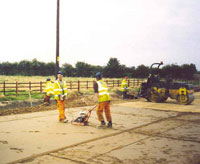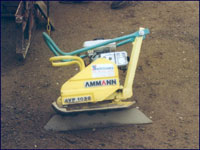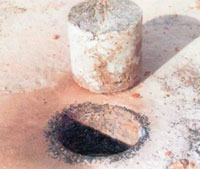In the United Kingdom, a procedure for building control joints in cement-treated bases (CTB) and roller-compacted concrete (RCC) pavements has now been used for over 10 years, with very good results. Control joints are used to induce shrinkage cracks in cement-treated materials in a controlled manner, thereby improving appearance and load transfer, and reducing maintenance. In the UK, this procedure is often called “pre-cracking”; however, in North America “pre-cracking” is more commonly used to describe “micro-cracking”, which is the initiation of cracks in CTB using a roller 2-3 days after construction. So, care must be used not to confuse the terminology.
 The UK control joint process involves creating a notch across the pavement with a vibrating plate in the fresh CTB or RCC after the paver has placed the material, but before it has been compacted with a roller. An asphalt emulsion is sprayed into the notch to provide a bond-breaking material. Then the layer is compacted with a roller, and the notch closes and often is not visible at the surface. After curing, shrinkage cracks will occur at the weak plane formed where the asphalt emulsion was placed.
The UK control joint process involves creating a notch across the pavement with a vibrating plate in the fresh CTB or RCC after the paver has placed the material, but before it has been compacted with a roller. An asphalt emulsion is sprayed into the notch to provide a bond-breaking material. Then the layer is compacted with a roller, and the notch closes and often is not visible at the surface. After curing, shrinkage cracks will occur at the weak plane formed where the asphalt emulsion was placed.
 Pictures of the construction process show a vibrating plate (commonly used to provide compaction around obstructions) with a ½-inch plate attached to the bottom that will create a notch in the material to a depth of one-half the layer thickness. In the UK, control joints for CTB and RCC are typically placed at 10 feet intervals in order to develop very small cracks. A significant advantage with the vibrating plate process is that when the notch is compacted, the sides of the crack will be in contact all the way to the top (although not bonded because of the asphalt emulsion). This aggregate contact results in better load transfer across the crack (see picture of core taken over a crack). Another advantage of using the vibrating plate is the low cost and simplicity, in comparison to saw-cutting or other procedures that require more advanced equipment.
Pictures of the construction process show a vibrating plate (commonly used to provide compaction around obstructions) with a ½-inch plate attached to the bottom that will create a notch in the material to a depth of one-half the layer thickness. In the UK, control joints for CTB and RCC are typically placed at 10 feet intervals in order to develop very small cracks. A significant advantage with the vibrating plate process is that when the notch is compacted, the sides of the crack will be in contact all the way to the top (although not bonded because of the asphalt emulsion). This aggregate contact results in better load transfer across the crack (see picture of core taken over a crack). Another advantage of using the vibrating plate is the low cost and simplicity, in comparison to saw-cutting or other procedures that require more advanced equipment.
 Engineers in the UK have studied the performance of test sections built with this control joint procedure for 10 years, using condition surveys, cores, and Falling Weight Deflectometer measurements (Ref 1). Results of the study were positive enough that the use of control joints is included in standard highway construction specifications, and that the design thickness of the asphalt surface can be reduced if control joints are used in the base.
Engineers in the UK have studied the performance of test sections built with this control joint procedure for 10 years, using condition surveys, cores, and Falling Weight Deflectometer measurements (Ref 1). Results of the study were positive enough that the use of control joints is included in standard highway construction specifications, and that the design thickness of the asphalt surface can be reduced if control joints are used in the base.
Reference
1. Ellis, S., and Dudgeon, R, “Pre-Cracking as a Technique to Minimise Reflection Cracking in Semi-Rigid Pavement Structures – Long Term Performance Monitoring”, Proceedings, Fifth International RILEM Conference on Cracking in Pavements, Limoges, France, 2004.